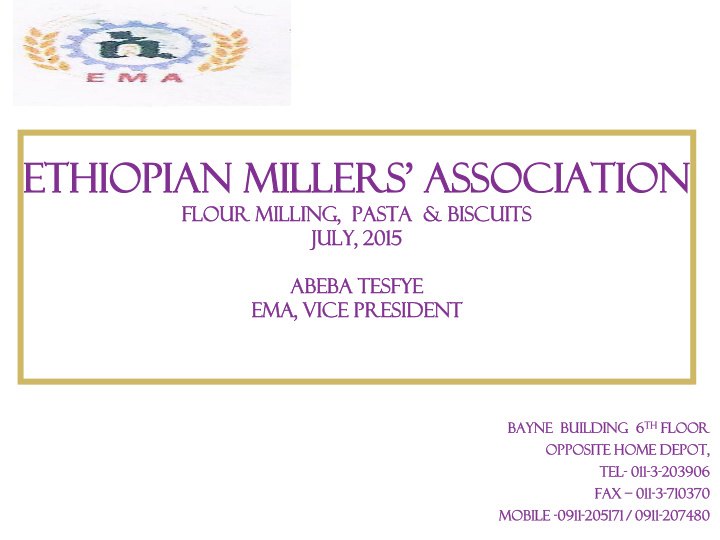



Ethiopian Millers’ Association Flo lour ur Milling, ing, Pasta sta & Biscui uits ts July, y, 2015 Abeba eba Tesfye ye EMA, A, Vice e Presiden ident t bAYNE YNE BUILDIN DING G 6 th th Floor or OPPOSI SITE TE HOME DEPOT, Tel- 011-3-203 03906 906 FAX – 011-3-71037 0370 MOBI BILE -0911-205 05171 / 0911-207 07480 80
Philanthropic Roots EMA Back Ground EMA stands for Ethiopian Millers’ Association . Organised in 2002G.C with 21 full capacity Milling Members. It started legally operations in 2004G.c Current number of Members is 122 out of around 682 flour millers in Ethiopia EMA is run by members annual membership fee Excellence in Milling Care
EMA EMA Vision Statement To develop and be recognized as a state of the art Milling Members Enhancement Centre in Ethiopia and Sub-Saharan Africa. To set a new standard of Milling in Ethiopia . EMA Mission Statement To provide highly competitive, technologically advanced and a comprehensive array of Milling services in order to deliver high quality Milling care with superior outcomes. EMA Cornerstones: Efficient Service & Support to Policy Makers, Partners & Members Technology Transfer Capacity Building of Members Continuing Partnership in development of Milling between Members and Foreign Millers’ Associations
ETHIOPIAN MILLERS’ ASSOCIATION Total number of active Mills in EMA Flour Factories – 110 **Mill Capacity- 45-900 tons / day Pasta Factories – 15 **Mill Capacity- 24-33 tons / day
EMA Operational Density % - 51% in Oromia Region -22% in Southern Region -17% in Addis Ababa -10% in other Regions Current Total Flour Milling Capacity is 10,858 ton/day (2,996,808 ton/year) *Due to wheat shortage, Members produce around 20-30% of their capacities.
Sources of Milling Machineries in EMA Percent 90 80 70 60 50 Percent 40 30 20 10 0 China Turkey Italy Switzerland
The objective of Milan Expo 2015 trip : -To acquire Italian food processing technology in order to produce quality products and increase efficiency to be competitive in the market and deliver our products at the reasonable price to the consumers. -Ultimately import substitute of wheat, pasta and macaroni. -Creating partnership with Italian partners.
WHEAT AND PASTA PRODUCTION IN ETHIOPIA Ethiopia is one of the largest grain producers in Africa, and the second largest wheat producer in Sub-Saharan Africa, after South Africa. Moreover, wheat is mostly grown in the highlands and mid highland area of the country . Among the nine regions, Oromia and Amhara regions produce 59% and 27% of the country’s wheat, respectively, with an additional 9% coming from the Southern Nations, Nationalities, and Peoples Region (SNNPR). Excellence in Milling Care
DURUM WHEAT AND PASTA PRODUCTION IN ETHIOPIA Ethiopia is the origin for durum wheat in the world .Some areas of the country like Oromia region is well known particularly, Bale zone is one of the main durum wheat growing areas. The food industry in Ethiopia is showing a remarkable growth to benefit from the population growth and urbanization. Currently this sub-sector i.e pasta and macaroni is growing very fast in terms of values and volume of production. It also contributes a significant portion to the gross value of production and marketing. The prediction also shows that this sub-sector will exhibit one of the highest growth rates in the manufacturing sector which is mainly dependent on locally produced raw material, wheat, implying that sustainability will not be an issue.
DURUM WHEAT AND PASTA PRODUCTION IN ETHIOPIA Considering such huge demand and potential agro- ecology; Ethio-Italian development cooperation in agricultural value chains in Oromia project put some effort to introduce and raise durum wheat production in the area. Moreover, EMA and Ethio-Italy project strengthened farmers’ linkage like contract farming between cooperative/unions with flour and pasta industries for supply of durum and soft wheat supply.
WHEAT AND PASTA PRODUCTION IN ETHIOPIA Despite the increased wheat production and productivity. Ethiopia is expending millions of dollars on wheat and pasta imports. Wheat Import trend Year 2008 2009 2010 2011 2012 Volume Imported ( 1.7 1.7 1.3 1.7 1.3 millions tons) Value of Import 295 137 79 128 122 (millions USD)
Flour, short and long cut pasta industry In addition, for the last three years, the country annually imported an amount of USD 28 millions of pasta and macaroni.
Pasta Import
Opportunities of Milling Industry in Ethiopia The country’s potential to grow wheat Conducive government policy in manufacturing sector The country has 4.7 million wheat producers High demand to pasta and macaroni
Current key challenges of Milling Industry in Ethiopia Limited domestic wheat supply. Weak linkage between producers and milling and pasta industries. Lack of advanced technological production methods and funding to expand, train, upgrade product diversification capacities Lack of skill up gradation trainings and world class production methodologies through foreign partners Infrastructural problem(shortage water, irregularity and shortage of electric power)
Current key challenges of Milling Industry in Ethiopia Inability of Millers to purchase additional grains from foreign markets Consumer oriented policies influence on processor ’ prices Market institutions are not improved Weak organized wheat value chain Alliance In availability of current data and information regarding the sector Limited resource of the association
The way forward Strengthen the association with resources. Strengthen the existing wheat value chain. The association cooperate with government policy makers, ministry of industry and other related government agencies. Strengthen the association’s relation with foreign partners. A company in the name “Ethiopian Millers’ inputs supplier share company” is under establishment. Strengthen cooperation with Ethio-Italy cooperation
COLLABORATERS We acknowledge some collaborators & We thank you for your time.
EMA EMA Excellence in Milling Care
Recommend
More recommend